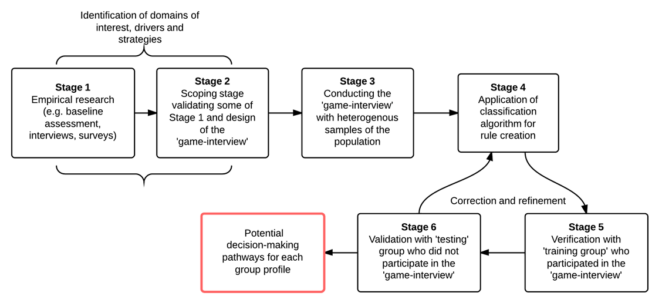Identifying Salient Drivers of Livelihood Decision-Making in the Forest Communities of Cameroon: Adding Value to Social Simulation Models

Introduction
Using research from southeast Cameroon, this paper describes a participatory and collaborative process for formalising qualitative data and explains how these results can provide input to a social simulation model. Insights to provide in better understanding decision-making in the region are also explained.
There has been some progress in the last few years linking qualitative and quantitative methods for agent-based modelling while maintaining a strong chain of evidence between models and their original data sources (e.g. through increased use of grounded theory, ethnographic and participatory methods for data collection, as well as the identification of context, scope and decision rules to structure narrative data). This evidence-to-model link is important so that agent-based models are transparent in their design and replicable by others. Knowledge Elicitation Tools (KnETs) are used, which build on ethnographic decision tree modelling (discussed in this paper).The use of KnETs seeks to improve the level of clarity in the pathway from evidence to model design, through rule-based output which crystallises important qualitative aspects of empirical evidence, using a ‘game-interview’. In addition, the procedure itself reveals patterns in decision-making profiles, tacit information and maintains a level of rigour similar to that of more traditional statistical approaches.
KnETs have been used to support a body of existing research on local strategies that build community adaptive capacity and support sustainable forest management under a range of socio-environmental and climatic stressors. The output of this approach is a set of decision rules which complements previous analysis of differentiated vulnerability of forest communities. Improvements to the KnETs methodology, such as new statistical measurements, make it easier to generate inputs for a social simulation model, such as agent attributes and heterogeneity, as well as informing which scenarios to prioritise during model development and testing.
This paper describes the participatory and collaborative KnETs process for formalising qualitative data. We present a case study in southeast Cameroon, where the KnETs approach has been applied. A description of the methodology follows, and finally recommendations for further applications of the approach, limitations and challenges are discussed.
*Download the full report from the right hand column. The key messages from the report are provided below. See the full text for more detail

Methods
Case Study
This research builds upon a case study in the Congo Basin, which is part of the ‘Climate Change and Forests in the Congo Basin: Synergies between Adaptation and Mitigation’ (COBAM) project on forest-based strategies that promote equitable impacts and co-benefits for both local communities and forests. In addition to reducing the vulnerability of communities in the region, an objective of the project is to study the governance of forest areas to promote sustainable use of forest resources and reduce the likelihood of deforestation and forest degradation, and thus carbon emissions. On this basis, this project aims to find strategies that could be synergistic in reducing social vulnerability while generating co-benefits for climate mitigation, which should include poverty reduction, enhancement of carbon and non-carbon ecosystem services and protection of local livelihoods and rights.
Since 2010, research in the COBAM project has applied a participatory approach to explore differentiated vulnerability, focusing on past trends and disturbances as well as current conditions, institutional analysis, social capital, and coping strategies resulting in a baseline vulnerability assessment.
This analysis was informed and complemented by semi-structured interviews and household surveys exploring socio-environmental histories and climatic vulnerability, coping mechanisms and forest governance. Following this baseline assessment, Knowledge Elicitation Tools (KnETs) were used to explore the future vulnerability of the area and possible options for adapting to a range of potential future socio-economic and climate scenarios that may support both forest conservation and community adaptation.
The KnETs approach: design and application
The diagram below shows the stages of the KnETs approach. A detailed description of the design and application of the KnETs process can be found in the full publication.

Lessons Learnt
The KnETs process served as a vehicle to structure a large volume of empirical data, to identify the most salient drivers of decision-making amongst different actors, to uncover tacit knowledge and to make recommendations about which strategic interventions should be further explored in a social simulation and by local organizations planning interventions.
Analysis of the KnETs results not only shows significant variation between male and female farming decisions in the case study area, but also between the women of poorer and better-off households. While all households try to spread risk, poor households chose more goals and were therefore dependent on more strategies, than better off households, which were more cash crop oriented.
However, it may be that a reliance on one or two crops that have benefits in the short-term can lead to new vulnerability in the long-term. Vulnerability may increase if climate becomes unsuitable for the crop, markets are not available or there is no longer diversification in cropping patterns due to the continual extensification of cocoa fields or unsustainable land management practises. For example, this could also become an issue if farmers reduce reliance on subsistence farming and use income generated from monoculture cash crops to buy food in the market or from other farmers in the village. This can become counter- productive in the long-term.
In summary, KnETs rules are empirically useful, since they reflect ‘our understanding’ of decision-making behaviour to quite a high level of accuracy based on informants’ responses. The interaction of these micro-level rules and their feedbacks in a social simulation at a system scale will be important in providing insights regarding possible implications of activities planned in local pilot projects. Once implemented, the social simulation could be validated in further workshops with communities in Cameroon to evaluate its potential in further improving our understanding of livelihood strategies that have co-benefits for both communities and forests.
Project Information:
Suggested Citation:
Bharwani, Sukaina, Coll Besa, Mònica, Taylor, Richard, Fischer, Michael, Devisscher, Tahia and Kenfack, Chrislain (2015) ‘Identifying Salient Drivers of Livelihood Decision-Making in the Forest Communities of Cameroon: Adding Value to Social Simulation Models’ Journal of Artificial Societies and Social Simulation 18 (1) 3 http://jasss.soc.surrey.ac.uk/18/1/3.html
Related resources
- Pilot Tools for Knowledge Elicitation (KnETs)
- Elimination by aspect and rule based decision making
- Climate Change and Forests in the Congo Basin: Synergies between Adaptation and Mitigation (COBAM)
- Safeguarding livelihoods and promoting resilience through National Adaptation Plans– Case study: Kenya
- Enabling opportunities to diversify farmers' livelihoods: Blending adaptation and mitigation practice
(0) Comments
There is no content